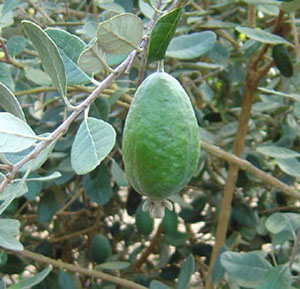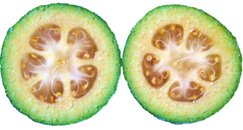Feijoa Nutrition Facts
Feijoa, commonly referred to as pineapple guava, is a delectably sweet and juicy fruit originating from South America. It enjoys widespread popularity in Brazil, Argentina, Bolivia, and New Zealand. Botanically, it belongs to the Myrtaceae family, either as a small tree or a shrub. Guava, rose apple and allspice are among the closely related plants within the Myrtaceae family.
Its scientific name is Acca sellowiana.
 |
| Feijoa fruit on a A. sellowiana tree. Courtesy: Briweldon |
Acca sellowiana is an evergreen shrub that typically reaches heights of about 8 to 15 feet and spreads out into a large bush. Its oval-shaped, thick, fleshy, deep-green leaves have a gray surface underneath. The plant produces attractive golden-yellow flowers with white petals and long maroon-colored stamens. After approximately 5 to 6 months of flowering, the bush becomes adorned with fruits ready for consumption.
Feijoa fruit is oval-shaped and closely resembles unripe medium-sized deep-green guava when viewed from a distance. It measures around 1/5 to 2.5 inches in length, 2 inches in diameter, and weighs approximately 50 grams. Once ripe, the fruit naturally falls from the tree and is typically gathered and consumed immediately. It emits a sweet fruity aroma reminiscent of a blend of banana and pineapple or pineapple and guava, hence its name pineapple guava. If not consumed promptly, the fruit will spoil relatively quickly unless preserved.
Internally, the fruit features a central, jelly-textured seed pulp surrounded by soft, grey-white flesh. The flesh is sweet, somewhat tart, and highly aromatic. Although the skin is edible, akin to guava, it is generally discarded.
Health benefits of Feijoa (Pineapple guava) fruit
Feijoas are low in calories; 100 g of fresh fruit holds only 55 calories. Nonetheless, they are low-fat, cholesterol-free fruits loaded with vitamins, and antioxidants that assure you a healthy state of well-being, free from illnesses.
The fruit is a very rich source of soluble dietary fiber (6.4 g per 100 g of fruit, about 17% of DRA), which makes it a good bulk laxative. The fiber content helps protect the colon mucous membrane by decreasing exposure time to toxins as well as binding to cancer-causing chemicals in the colon.
Feijoa fruit is an excellent source of antioxidant vitamin-C. 100 g fresh fruit provides 32.9 mg of this vitamin, about 55% of DRI (daily recommended intake). Vitamin C is a water-soluble antioxidant that works well against viral illness through immune-boosting means. Regular consumption of fruits rich in vitamin C helps the human body develop resistance against infectious agents and scavenge cancer-causing harmful free radicals from the body.
Feijoa contains small proportions of B-complex vitamins such as pantothenic acid, niacin, vitamin-B6 (pyridoxine), and vitamins E and K, as well as minerals like calcium, magnesium, copper, and manganese.
| Principle | Nutrient Value | Percent of RDA |
|---|---|---|
| Energy | 55 Kcal | 3% |
| Carbohydrates | 13 g | 10% |
| Protein | 0.98 g | 2% |
| Total Fat | 0.6 g | 2% |
| Cholesterol | 0 mg | 0% |
| Dietary Fiber | 6.4 g | 17% |
| Vitamins | ||
| Folates | 23 µg | 6% |
| Niacin | 0.295 mg | 2% |
| Pantothenic acid | 0.223 mg | 2.5% |
| Pyridoxine | 0.067 mg | 5% |
| Riboflavin | 0.018 mg | 1.5% |
| Thiamin | 0.006 mg | 0.5% |
| Vitamin A | 6 IU | <1% |
| Vitamin C | 32.9 mg | 55% |
| Vitamin E | 0.16 mg | 1% |
| Vitamin K | 3.5 µg | 3% |
| Electrolytes | ||
| Sodium | 3 mg | <1% |
| Potassium | 172 mg | 3.5% |
| Minerals | ||
| Calcium | 17 mg | 2% |
| Copper | 0.036 mg | 4% |
| Iron | 0.14 mg | 2% |
| Magnesium | 9 mg | 2% |
| Manganese | 0.084 mg | 4% |
| Phosphorus | 19 mg | 3% |
| Zinc | 0.06 mg | <1% |
| Phyto-nutrients | ||
| Carotene-ß | 2 µg | -- |
| Crypto-xanthin-ß | 3 µg | -- |
| Lutein + zeaxanthin | 27 µg | -- |
| Lycopene | 5 µg | -- |
Selection and storage
Feijoa season varies depending on the location. In Brazil, they appear in markets from late March to July. In New Zealand, you can find them from March to June, although they're often available in supermarkets for longer.
When shopping, seek out fresh arrivals. Opt for dark green, ellipsoid-shaped fruits with a distinct fruity scent. Check for any signs of damage like bruises, cuts, or blemishes and avoid those. A ripe feijoa will yield slightly to gentle thumb pressure.
Once ripe, feijoas don't last long at room temperature, usually no more than two days. If not eaten promptly, store them in the refrigerator for up to 1-2 days. Alternatively, they can be kept in the freezer for a couple of months.
Preparation and serving methods
 |
| Feijoa fruit cut section. Courtesy: Pingked |
To prepare feijoa, start by selecting fresh, ripe fruit. Gently rinse and pat dry. Cut the fruit in half with a paring knife, then scoop out the juicy pulp using a spoon, similar to how you would with sapodilla. The flesh has a sweet-sour taste and a sandy texture, while the skin, although edible, is usually discarded.
Here are some serving ideas:
- Enjoy the fruit as is to savor its natural flavor.
- Juice it for a delicious drink.
- Add aromatic slices to salads.
- Incorporate it into baked goods like muffins and cakes.
- Use it to make purees, jellies, jams, chutneys, juices, sorbets, and more.
Safety Profile
Feijoa fruit consumption is considered safe for human health, including for pregnant mothers and infants. medical disclaimer for more information).
≻≻-Back to Fruits from Feijoa. Visit here for an impressive list of all varieties of fruits with complete illustrations of their nutrition facts and health benefits.
≻≻-Back to Home page.
Further reading and Resources:
Stanford School of Medicine Cancer information Page- Nutrition to Reduce Cancer Risk.